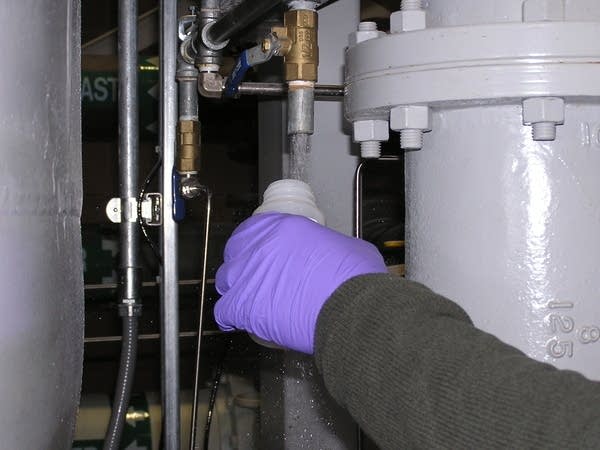Public pressure pushes PFC investigations
Go Deeper.
Create an account or log in to save stories.
Like this?
Thanks for liking this story! We have added it to a list of your favorite stories.

The activity at a former dump site in Washington County is symbolic of the work to come on PFC's in Minnesota, and just how complex the job could be.
"We think the PFC waste is in the southeast corner, but since there wasn't really good records of where different waste went, we're really not sure," says Minnesota Pollution Control Agency hydrogeologist Ingrid Verhagen.
The MPCA took over this landfill in 1998. So the agency is now responsible for cleaning up the 3M chemicals that are leaking into the groundwater.

Verhagen says one idea is to build a treatment plant at the landfill that will filter the contaminated groundwater. There's another option. But it's expensive.
Turn Up Your Support
MPR News helps you turn down the noise and build shared understanding. Turn up your support for this public resource and keep trusted journalism accessible to all.
"We've been thinking about digging up the waste, developing a lined facility, on site, and putting the waste all back in there, so that it can't leak to the groundwater anymore."
It would be a monumental effort to remove the two and a half million cubic tons of waste at this site and re-entomb it in a liner.
The state and 3M will make many decisions like this in coming months at three other major sources of PFC contamination in the east metro.
But the investigation won't stop here. The MPCA also plans to search for PFCs in dozens of active landfills and wastewater treatment plants scattered around the state. The agency wants to know whether the stain resistant fabrics and water proof coatings we throw away are contributing to the problem, according to MPCA environmental studies supervisor Paul Hoff.
"Is it coming from consumer products? Is it coming from commercial applications, industrial, regular old wastewater? And that, we hope, will help us understand why again you find PFCs in faraway places, not just downstream from where they were manufactured," he says.

Hoff says the MPCA hopes its landfill and wastewater studies will help the agency figure out if something can be done to prevent products containing PFCs from getting into the waste stream in the first place.
"While much is still really unknown and in debate about how serious PFCs really are, on the loose in the environment, they are not a natural substance. They shouldn't be there. If there are ways around it and easy substitutions, those would be desirable."
Since January, there's also been a flurry of Health Department water testing in the east metro. The testing was prompted by the discovery of PFBA in eight suburbs, including Cottage Grove and Woodbury. More than 500 people attended community meetings that helped create public pressure for more testing and more information.
In addition to the new testing, the Health Department is also monitoring some other PFCs that have been a problem for a while now. Oakdale is one location.

"These are filled with carbon, about 20,000 pounds of granulated activated carbon a piece," says Health Department engineer Chad Kolstad, while flipping open a spigot at the base of two large tanks. Together the tanks filter thousands of gallons of Oakdale water each day.
Oakdale has PFC contamination in seven of its eight municipal wells. Currently the city is only operating two of its wells. Both are connected to a new $2 million filtration system that was paid for by 3M. In a statement released to MPR news, the city of Oakdale says the community's water is safe to drink.
"Oakdale has taken great lengths to quickly pass all information to the community and to work with the Minnesota Department of Health, the Minnesota Pollution Control Agency and the 3M Corporation to effectively address this serious situation," the statement said.
Kolstad is in Oakdale to take a monthly water sample, to make sure the tanks are doing their job. So far these filters have been effective at removing two 3M chemicals of concern, PFOA and PFOS. But soon it will be summer and Oakdale will have to start tapping some of its remaining unfiltered wells to meet the increased demand for water. One of those wells recently exceeded safe health limits for PFCs when the health department issued new guidelines last month.

Oakdale Public Works Director Brian Bachmeier says the city has been in talks with 3M about ways to fix the situation as soon as possible.
"We're going to be looking at drilling an additional well, a new well for the City of Oakdale on the north side of our community in an area outside the plume (of chemicals)."
Even if Oakdale gets its well situation resolved this year, there are still dozens of other municipal wells in other east metro communities that have varying levels of perfluoro-chemicals in their water. It's not clear yet what will happen in those communities that have tested positive for PFBA.
Legislators have also felt public pressure to take action on the PFC issue. A proposal sponsored by Sen. Kathy Saltzman, DFL-Woodbury, would require the Health Department to conduct tests on charcoal filters to determine which types of filters are the most effective at removing PFBA.

Another bill, sponsored by Sen. Katie Sieben, DFL-Cottage Grove, would require the Health Department to establish a bio-monitoring program in the state to track the levels of PFCs found in residents' blood. She says the voluntary program would give the state invaluable information about what's happening to people's health over many years.
"Just because there's a high level of exposure doesn't necessarily equate to a causal relationship to cancer or anything like that. But we need to start collecting this data to get some sense of if there are relationships between environmental contamination and people's exposures to PFCs," she says.
During a legislative hearing on a related bill March 14th, Sieben invited Dr. David Gray to tell lawmakers about the latest research into PFCs. Gray is the former Chief of the Health Risk Assessment Division at the Minnesota Department of Health. He's now an expert witness for the plaintiffs in a lawsuit against 3M.
Gray told the committee there's been an explosion in new information about the toxicology of the materials.
"As time goes forward we learn more and more toxic effects that are occuring at lower and lower levels of exposure in experimental animals. All of these studies serve to heighten our concern about human exposure to these materials, none of them to my knowledge serve to lessen our concern." 3M disagrees with that conclusion. The company says the level of perfluorochemicals detected in the environment to this point are too low to cause harm in humans. But 3M says it would support a bio-monitoring proposal if it was collected by public health professionals.
3M's Medical Director Dr. Larry Zobel says the company agrees the information would be useful, even if the results reveal high levels of the chemicals in people's blood.
"If the levels are high, they're high. I mean, we have to deal with the world as it is. If the levels are high, we would have to, or whoever was making the decisions would have to deal with that fact and interpret it properly and then follow up with the right measures."
Answers to many of the scientific questions about PFCs could be years away. But the quest to find the chemicals in Minnesota and clean them up is entering a new phase.





